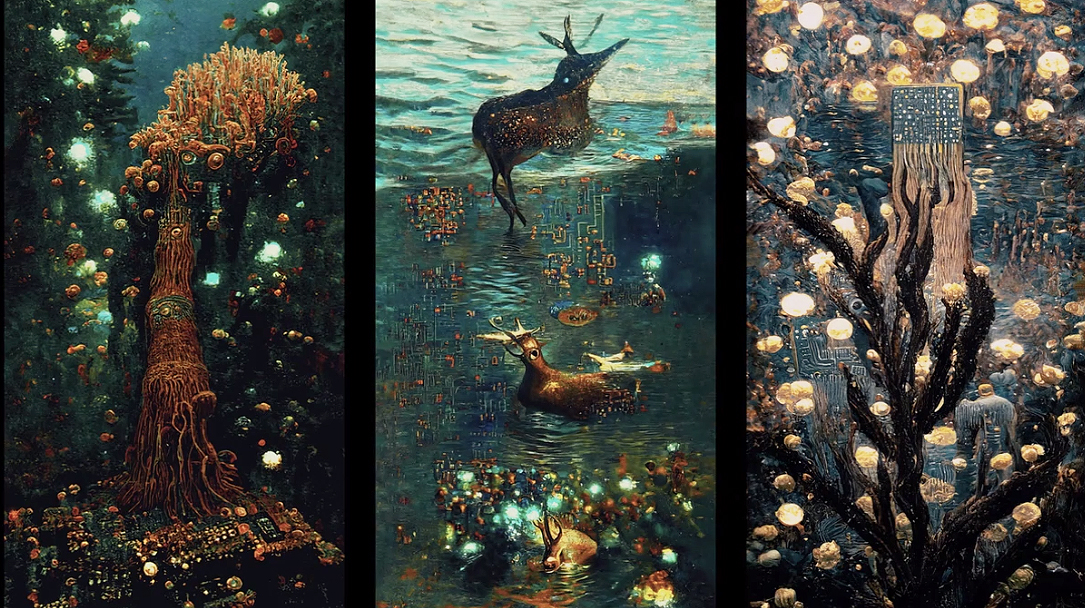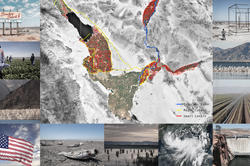Grad students Ann Lewis and Viraj Mithani, undergrad Yuqing Liu and recent alumna Elizabeth Meiklejohn use SPUR funding to conduct research in the US and abroad.
Computation, Technology and Culture Studio Encourages RISD Students to Explore AI

Does Pope Francis really wear a Balenciaga puffer coat? Did Vladimir Putin learn English just so he could post that video telling American voters that democracy is dead? What’s the story with that new Drake track that appeared and then quickly disappeared from YouTube?
The answer to all of these questions is the same: AI. New tools incorporating artificial intelligence like ChatGPT and Midjourney are getting more and more sophisticated every day, allowing users to create technically “new” (and ambiguously copyrighted) works in seconds. By typing a few descriptive words into a search field, you can now create new works “by” Picasso, write a thesis paper on any conceivable topic or render an architectural masterpiece that blows Antoni Gaudí’s Sagrada Família out of the water.
“Deepfakes are one example of the AI products that we’ll soon take for granted” says RISD faculty member Griffin Smith. “We focus on the political dangers, but there are also creative opportunities in capturing a person’s face, a singer’s voice or an artist’s style in an AI model.” The digital artist and machine learning expert is currently teaching two courses on AI at RISD: Machine Learning: Applications and Aesthetics and Machine Learning and the Arts (offered through the Computation, Technology and Culture concentration).

“What matters most is the conceptual aspect of the work and how well the concept was executed.”
“Everyone in my classes is excited and scared at the same time,” Smith says, “and that’s a privilege for artists. It’s good to make work that feels relevant. We have to rise to the occasion and produce works that speak to our shared fears.” Things are progressing so quickly, he adds, that it’s hard to keep up.
Norwegian artist, researcher and former architect Feileacan McCormick—who visited Smith’s class earlier this semester—has been using AI to meditate on ecology and nature with his colleagues at Entangled Others Studio since long before the technology became as advanced as it is today. McCormick explained how his Hybrid Ecosystems project presented “neural-speculative visions of reality that attempted to manipulate and distort our mundane view of the world and allowed us to see harmoniously interacting artificial and natural life as one single, sustainable ecosystem.”


Is he concerned that the work he has created using outdated technology will itself be seen as outdated? “The work is still valid,” McCormick maintains. “This narrative of progress (bigger, larger, better) should not affect our take on existing pieces. What matters most is the conceptual aspect of the work and how well the concept was executed.”
In early May, students presented their own conceptual projects focused on everything from integrating AI into architectural design projects to creating an online speed dating app that tests the user’s ability to recognize the difference between real people and bots.

Virtual Cupid, created by junior Taylor Burgess 24 IL using Twine and Midjourney, incorporates a variety of would-be romantic connections who ask the user questions about their hobbies, interests and life goals. “I like narrative-based work and learned that AI cannot write very well,” says Burgess. “I had to do a lot of editing to ensure that the characters didn’t all sound the same and have that tone of a customer service representative.”
Senior Shun Huang 23 GD intentionally created a program that refuses to answer questions or cooperate in any way. When a student who volunteered to help demo the project asks GPTFail for the basic ingredients in a cake, it responds, “I have no interest in teaching humans to bake.” The idea behind the project, says Huang, is that people are using AI almost exclusively to increase productivity. GPTFail, she adds, should allay people’s fears about losing their jobs to AI.
“I found that GPT4 did a good job of creating fake user personas and generating an affinity diagram of user pain points and possible solutions.”
On the other hand, a beautiful deck of tarot cards created by Rujia Xia 24 GD with the help of ChatGPT4 and Midjourney does attempt to provide the user with answers (that are about as specific and useful as the typical horoscope reading you’d find online). And fellow junior Sunjoo Park 24 ID discovered that using AI to redesign a banking app worked well.
“I used the same steps I typically use to design: empathize, define, ideate, prototype, test,” says Park, “and found that GPT4 did a good job of creating fake user personas and generating an affinity diagram of user pain points and possible solutions.”
“I appreciate your focus on data,” Smith said after the demo. “Your redesign is definitely more responsive than the original banking app, and I have no doubt that AI will get better and better at contributing to design once it is integrated into other tools like Figma.”
—Simone Solondz / top photo by Isabel Roberts
May 18, 2023


